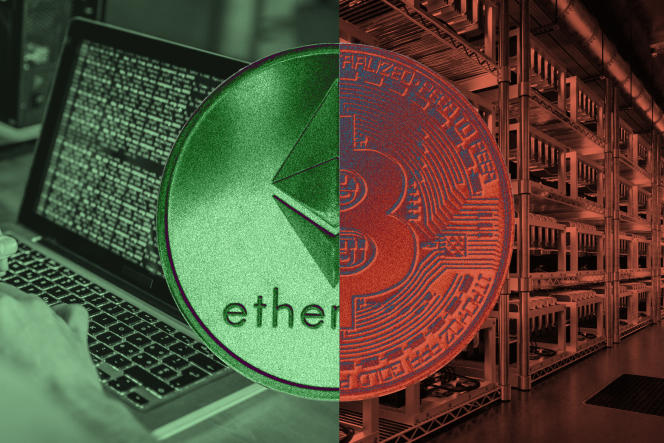This is a major transition that the Ethereum platform must tackle from September 15. Dubbed “the Merge”, and repeatedly postponed due to technical difficulties, it involves switching the platform and associated cryptocurrency, ether, from an evidence-based protocol proof-of-work to another based on proof-of-stake. A choice that comes after long debates and several years of research by the founder of Ethereum, Vitalik Buterin, and the developer Vlad Zamfir, which can have serious implications for the sector.
Cryptocurrency networks like bitcoin are primarily digital ledgers, whose activity is sealed by a “blockchain”, which compiles network transactions. To guarantee the validity of this registry and reliable operation, users must operate according to common rules.
It was in the white paper presenting bitcoin in 2008 that Satoshi Nakamoto, the pseudonymous inventor of cryptocurrency, popularized the notion of proof-of-work. Imagined by scholars from Harvard and the Weizmann Institute in 1993, this computer protocol was used at the time to combat spam. The concept authorizes access and participation in a network through the execution of a task, and therefore the use of resources, in the same way that an Internet user is often forced to solve a “captcha”, a test of manual identification to prove that he is not a robot.
With bitcoin, the production of blocks integrating transactions is carried out by “miners” – computers whose resources are devoted to securing the network. To produce a block and continue the continuity of the chain, it is necessary to carry out calculations. The first miner to successfully complete the operation is rewarded with bitcoins. The more network participants there are, the more complex the calculations.
The method is therefore costly in terms of energy. A desire of its creator to curb the ardor of malicious actors: compromising the integrity of the network indeed involves spending phenomenal resources. In the case of bitcoin, the computing power required by the network is such that a maneuver of this type, according to estimates by the sites Crypto51 and GoBitcoin, would cost between 18.7 and 22 million euros per day in electricity expenses. , to which must be added the hardware cost of the mining computers, estimated between 15 and 30 billion euros. A prohibitive cost in this case but much less for other less used cryptocurrencies, such as Vertcoin, Ethereum Classic or Bitcoin Gold, corruptible for sums sometimes less than ten thousand euros.
In summary, with proof of work, the security of a blockchain is correlated to the amount of energy resources deployed. With an annual consumption of 86.6 terawatt hours (TWh) according to the University of Cambridge, the bitcoin network ranks between Belgium (81.2 TWh/year) and the Philippines (90.9 TWh/year) or similar consumption “to that of a big city, like Los Angeles”, as former miner Marc Bevand preferred to qualify with Le Monde, in June 2021.
A legitimate energy expenditure, for supporters of bitcoin, its inventor evoking in the white paper a model “analogous to gold diggers spending resources to add gold in circulation”. Jack Dorsey, the founder of Twitter and electronic payment start-up Block, and Tesla CEO Elon Musk consider that “bitcoin promotes renewable energy”. Conversely, others, such as Greenpeace, rightly vilify the exorbitant energy cost of this model in favor of that of proof-of-stake, proof of stake.
Unlike proof of work, this consensus method that appeared in 2012 with the Peercoin cryptocurrency does not require the execution of a task to participate in the network but to prove possession of the cryptocurrency in question. For this, it is necessary to sequester part or all of its capital in order to participate in the validation of transactions and the creation of blocks. With this consensus, potential malicious actors are this time sanctioned by the loss of their capital. The receivership therefore theoretically ensures that good behavior is guaranteed.
To compensate for the temporary unavailability of funds, users are rewarded by receiving the currency created simultaneously with the new block. Here, the proof of stake is reminiscent of a French passbook: the more funds locked up and the longer they are locked up, the greater the reward in the form of interest.
For most cryptocurrencies using the “proof of work” consensus, the physical cost of participating in the network is limited to owning a simple computer, or even a mobile phone, which is a pittance compared to the cost machines dedicated to bitcoin mining (between 2,000 and 10,000 euros on average). On the other hand, if from the first euro spent, the holder of this type of currency can in theory hope to receive a remuneration, this protocol favors the largest wallets: the greater the capital, the greater the chance of cashing the reward. too.
In the case of Ethereum, the code requires the escrow of 32 ethers to participate in block validation. Given the current price of an ether (1,578 euros), Ethereum will therefore request an escrow of approximately 50,000 euros.
A cost criticized by supporters of the proof-of-work mechanism, who believe that the proof-of-stake system goes against the idea of a peer-to-peer network distributed fairly. “Proof of stake consumes much less energy than proof of work, but the other side of the coin is that it creates much more centralization”, castigated Pierre Rochard, economist of the American platform of exchanges of Kraken cryptocurrencies. A criticism dismissed by Vitalik Buterin who, in an article published in May on the technology site Hackernoon, estimated that “the minimum necessary to put in receivership is relatively low and attainable for most people”.
There remains the question of potential bugs caused by the transition from one protocol to another. In May, in the case of Ethereum, the test blockchain intended to merge with the current version experienced a flaw in the form of a reorganization of its history. And more recently, in August, a flaw was detected on the main client used by the protocol. Real hiccups for a technology supposed to ensure the immutability of its register.














